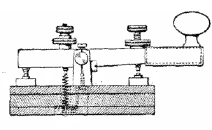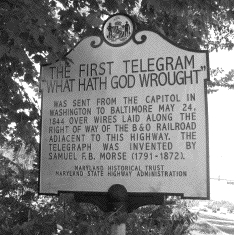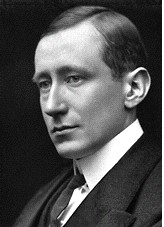(E28) Electric Communication
For thousands of years the preferred mode of rapid communication was man on horseback. Herodotos wrote of the messengers of the ancient Persian empire
The Electric TelegraphThe invention of the electromagnet made electricity the method of choice in long-distance signaling on land. In Britain, Cooke and Wheatstone developed a system with 5 insulated wires, each of which could move a magnetic needle: any simultaneous shift of two needles encoded a letter of the alphabet. However, the most successful telegraph was developed by Samuel B.F.Morse, a US artist. Morse (1791-1872) studied at Yale and in Europe and became a quite successful painter of portraits. His most famous oil painting (1821-2) was of a session in the old US House of Representatives in the Capitol. It is a large painting with many of the faces of representatives recognizable, and was exhibited around the country for a fee; the original is now on display at the Corcoran Gallery in Washington and a small version is displayed in the hall which Morse painted, now housing statues of famous Americans. Morse learned about electromagnets on a sea voyage in 1832. Wilhelm Weber and the mathematician Carl Friedrich Gauss had constructed a magnetic telegraph connecting their lab (later downed by lightning) and Morse decided to develop a telegraph of his own, using a single wire and return through the ground. He devised the Morse Code encoding letters, numbers etc. as combinations of "dots and dashes", short and long pulses fed over the telegraph line to a distant receiver. There the electromagnet placed marks on a paper tape, slowly advancing past it by clockwork. For instance, 3 dots make the letter "S", 3 dashes the letter "O", so ...--- ... spells "SOS" and is the universal distress code ("Save Our Ship" or "Save Our Souls"). 
The Morse code is still widely used by amateurs, by some simple signaling devices and in emergencies. The transmitter is the "Morse key" (see image), a bar pivoted in the middle, with a knob at one end. That end serves as a switch normally kept open by a small spring, while a screw at the other end limits the opening distance of the switch. The hand of the operator on the knob closes it for short or long intervals, and an electric battery provides the current. 
Congress in 1842 finally authorized a telegraph line from Washington to Baltimore, operated after 1844 (the plaque shown is along US Rte. 1 in Beltsville, Md., south of the Muikirk Rd. overpass). The telegraph spread rapidly (especially along railroad lines) and Morse's elaborate paper tape instrument was soon dispensed with when a telegraph operator named James Francis Leonard learned to listen to clicks of the magnet and decode the message by ear; his example set a new trend (other telegraphers may also have made that discovery). He died of typhoid while serving in the Confederate army and his grave in Frankfort, Kentucky was later marked by a 12-foot marble monolith (thank you, Greg Good, for this story). Thomas Alva Edison, the inventor, started his career as a telegraph operator. In the US Civil War the telegraph was used extensively--even to communicate from tethered observation balloons to the ground. Incidentally, electricity was also used by the Confederate military to set off underwater mines, known as torpedoes. When Admiral David Farragut, in the battle of Mobile Bay, said "Damn the torpedoes... full speed!" he ordered his ships to continue the attack even though one has been sunk by a mine. Russia used similar mines in the Crimean war. The cigar-shaped underwater missile guided by gyroscope, initially known as the "Whitehead Torpedo," was developed (much later) in Europe. Soon after the telegraph was invented, undersea telegraph cables were laid, starting with an 1850 link between England and France. In 1857-8 a cable was laid between Europe and the America, but it operated very slowly and soon failed. Another was laid in 1866, but the capacitance and inductance of the long line distorted the signal--what was sent out as crisp square blocks arrived arrived with profiles like heaps of sand, which tended to blend if they were not widely spaced. William Thomson--later Lord Kelvin--was active in advising the cable construction, and later Oliver Heaviside and Michael Pupin modified the cable to reduce signal deterioration. Cables in the 20th century contained "repeater" amplifiers to preserve the signal, while modern technology introduced lasers and fiber optics, also communication satellites. (Click here for the last message sent by Samuel Morse, and the statue in his honor in New York City).The TelephoneThe credit for inventing the telephone, transmitting speech by electricity, is still being debated. A patent was granted in 1876 to Alexander Graham Bell, a teacher to the deaf, and his system ultimately prevailed in the patent courts. A simple "dynamic" telephone has a receiver with a diaphragm, set to be vibrated by the speaker's voice. Attached to it was a lightweight wire coil surrounding a magnet, free to move without touching it, and the vibration generated an induced current. The current ultimately reached a somewhat similar set-up in the earpiece, except that here the coil was vibrated by the current it received, causing the diaphragm to oscillate and generate a sound. The use of such a "dynamic" phone spread rapidly, but it had two limiting factors. One, the energy transmitted was limited by the electricity the input sound could generate. This was overcome in 1877 by the carbon granule microphone of Thomas Edison and Emil Berliner. An electric battery fed current through a small box containing carbon granules in loose contact, which a voice-activated diaphragm compressed and relaxed. This affected the resistance of the granules and created a signal which transmitted voice, though its quality was mediocre. The energy was now produced by the battery and the signal was large enough that sometimes the receiving detector was just a loose thin iron plate, attracted by an electromagnet. After the invention of the vacuum tube amplifier (later replaced by solid-state devices) the signal could be easily amplified further, and with better quality. A related invention by Edison was the phonograph, recording music and speech through a groove in a cylinder rotated by clockwork. A sharp stylus attached to a diaphragm created the groove, and the sound was encoded by tiny wiggles in it. Later (1887) Berliner replaced the cylinder by a disk of hard rubber, made by hot pressing from a master recording. The reproduced sound came from another diaphragm, attached to a needle which tracked the groove. At first this was a purely mechanical device, without electricity. The clockwork had to be wound up anew every few minutes and the sound was rather tinny. Electronic amplification improved the sound and the volume, plastic records made possible long-playing records (about 45 minutes instead of 3), and later magnetic tapes and disks, as well as laser disk players and electronic memories, replaced the technology and improved the recording of sound. The second limitation was that telephone users needed a network. With early telephones, each user had a line to the switchboard and a hand-cranked magneto, attached to the line but isolated from the sound transmission by capacitors. To make a call, the user gave the magneto a few turns, ringing a bell in the switchboard office and raising an iron "flag" held by an electromagnet, identifying the calling line, or in later versions turning on a small electric light. The operator (usually a woman) would then use a cord to plug her phone into the line and ask whom to connect, then shift the cord to the receiving party and ring the bell there. When the call ended, the 'flag" dropped or the light went out, and the operator pulled out the connecting cable. Later this was replaced by massive automatic machinery based on magnetic relays. A relay is an electric switch closed by an electromagnet--probably invented by Joseph Henry and allowing a small input of energy (in the magnet) to control a much larger current (in the switch). The user inserts a finger in one of to holes around a dial and pulls; a spring then returns the dial to its starting position, producing 1 to 10 clicks (depending on the hole the finger pulled). A motor in the automatic switchboard then rotates a "stepping switch" one position for every click, encoding a number 1 to 10 (marked 0 to 9). Four pulls on the dial can thus encode numbers up to 10,000, activating 4 switches to connect the proper phone line. That was then--nowadays solid state circuits and computers do all the switching and more. RadioThe creation of radio waves by Heinrick Hertz was just the first step. Hertz died at a young age, but the Italian inventor Gugliemo Marconi successfully expanded his invention and turned it into a commercial success (earning a Nobel prize along the way). Initially, radio waves were detected by coherers, glass tubes filled with metal shavings. Radio waves made the shavings cling together, increasing the tube's electric conductance and thus able to detect signals in the Morse code (and also detect lightning, by Aleksander Popov in Russia in 1894).
Marconi experimented with radio devices, improved them and increased their range. Somewhat unexpectedly, radio signals (unlike light) were found to be able to travel beyond the horizon (especially at night), suggesting to Oliver Heaviside that they were reflected by an electrically conducting layer in the high atmosphere. "The Heaviside Layer" is now known as the ionosphere, created by sunlight of very short wavelength, with the lowest "D layer" (which absorbs lower frequencies) recombining after sunset. Using a ship Marconi studied the range and worked to extend it, and in 1903 his shore station at Cape Cod, Massachussetts, detected transmissions from England. (The remains of the station are now part of a National Seashore Park, but were relocated further inland after parts of the shoreline were washed away in storms.) His company employed Reginald Fessenden to build high-frequency spark transmitters for ships, from which came the nickname "Sparks" for naval radio operators and the German verb "funken" (to spark) for wireless communications. Another employee was David Sarnoff, who reputedly picked up distress signals from the sinking "Titanic" and who later headed RCA, the Radio Corporation of America. Radio advanced tremendously after Lee Dr Forest in 1906-8 introduced his triode vacuum tube which controlled a current emitted in vacuum from cathode heated by an electric filament. The electrons were collected by an "anode" at a higher positive voltage (which attracted electrons), and could be modulated by a spiral wire or "grid" placed between the two. A positive grid reduced the flow of electrons, a negative one helped draw them out, making possible amplifiers of sound and of radio waves (in both transmitters and receivers). By feeding part of the signal back to the grid, through a filter tuned to one frequency, a strong radio "carrier wave" could also be obtained, on which the sound was encoded. Since then, vacuum tubes were replaced by "solid state devices" based on crystalline silicon with suitable impurities added. The frequency of radio was gradually increased, leading to radar, microwave ovens, communication satellites and radio telescopes. All these however are beyond the scope of this introduction. |